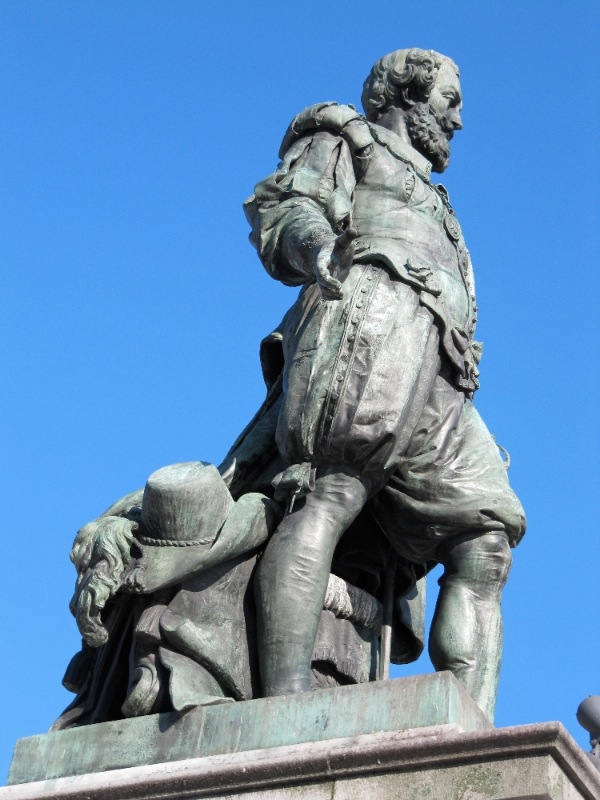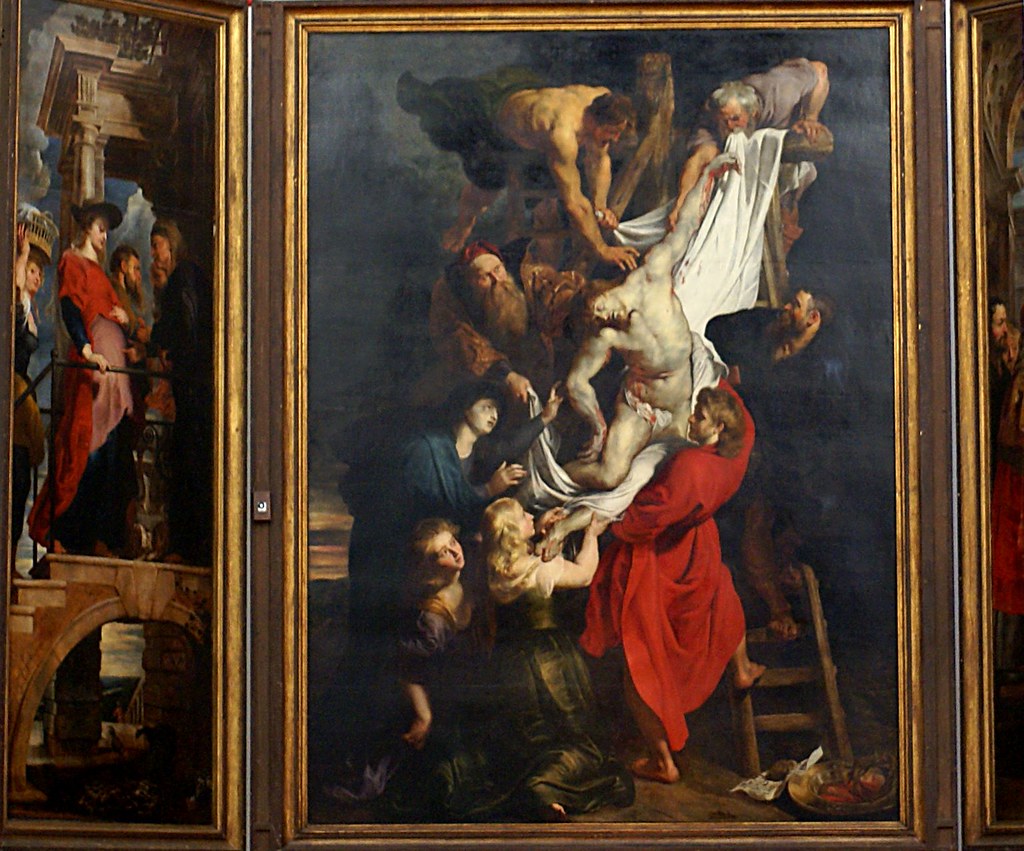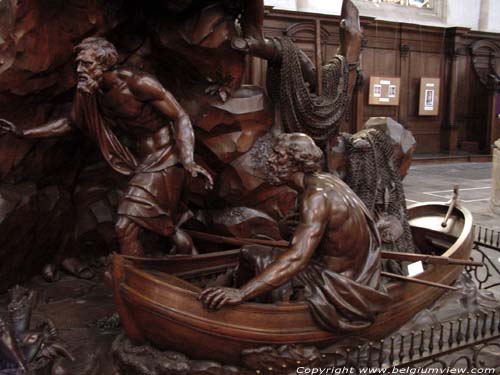Rubens’ statue
One of the most popular meeting places in town is at the feet of Rubens’ statue on the Groenplaats. This used to be a green churchyard (i.e. one without gravestones for ordinary people). But be assured: the bodies have long since been taken away and are now replaced by car that are parked in the garage underneath.

History
The statue was made by a local sculptor W. Geefs to commemorate the 200th anniversary of Rubens’ death in 1840. Unfortunately Geefs did not succeed in getting his sculpture ready in time. He cast a plaster copy and had it transported to the place it was supposed to stand originally: the Steenplein. Suddenly the casting slid from the carriage and was broken to pieces. Eventually it was three years later, in 1843, that the image was placed on the Groenplaats.
Again things didn’t go as planned: it had been raining quite heavily, the ground was soaked and a wheel slid into what had probably once been a grave. Rubens again fell to earth, but fortunately this time he was made of bronze and survived the drop.
Description
Greefs portrayed Rubens in his three dimensions: as a gentleman, as a diplomat and as a painter. It seems that the previous aspects were more important to Greefs than his artistic side. His palette lies behind his feet, together with a bag filled with documents. More prominent is the rich way he is dressed. It is clear this is not just anyone, on the contrary a very important person. Just watch the self confident way he stands there, the left hand carelessly resting on his sword, the right hand stretched out to bid us all welcome to his city. And maybe also to some his nicest works in the cathedral behind him.
Rubens does not face these works, neither does he look at his house and workshop. Instead he looks straight south. Might he be looking at Italy, where he perfected his craft as prof. Claes suggested in his book “Van Mensen en Steden”?
More on W. Geefs can be found on Wikipedia.
 Although a number of historical churches have vanished (e.g. the Walburgischurch in the very center of the old town, and the church belonging to the St-Michael’s cloister in the environment of the Kloosterstraat), we still have 5 churches with a rich historical background.
Although a number of historical churches have vanished (e.g. the Walburgischurch in the very center of the old town, and the church belonging to the St-Michael’s cloister in the environment of the Kloosterstraat), we still have 5 churches with a rich historical background. The youngest of the historical churches is the Jesuits’ church: St-Carl-Borromeus. Its façade is a fine example of baroque art, but only inside will you be able to feel the effect of baroque completely, especially when you enter the Houtappel chapel (to your right facing the main altar). Also this church is closely connected with Rubens as there are clear signs that Rubens had a hand in the design of both the façade and the tower. Originally the aisles left and right had their ceilings painted by Rubens, but a fire in 1718 destroyed all of these paintings. Rubens also painted two large canvases for the main altar, but the originals are now on display in Vienna. The really unique thing about this church is that the painting adorning the main altar can be switched. The original device to perform this feat is still active and is being used four times a year.
The youngest of the historical churches is the Jesuits’ church: St-Carl-Borromeus. Its façade is a fine example of baroque art, but only inside will you be able to feel the effect of baroque completely, especially when you enter the Houtappel chapel (to your right facing the main altar). Also this church is closely connected with Rubens as there are clear signs that Rubens had a hand in the design of both the façade and the tower. Originally the aisles left and right had their ceilings painted by Rubens, but a fire in 1718 destroyed all of these paintings. Rubens also painted two large canvases for the main altar, but the originals are now on display in Vienna. The really unique thing about this church is that the painting adorning the main altar can be switched. The original device to perform this feat is still active and is being used four times a year. Another church linked with Rubens is St-James’s, located near St-Jacobsmarkt, entrance via the southern aisle in Lange Nieuwstraat. Here the master is buried beneath a painting of his own choice. This church boasts a very impressive main altar in baroque style and an organ on which the young Mozart one gave a concert as he passed Antwerp in the company of his father and his sister.
Another church linked with Rubens is St-James’s, located near St-Jacobsmarkt, entrance via the southern aisle in Lange Nieuwstraat. Here the master is buried beneath a painting of his own choice. This church boasts a very impressive main altar in baroque style and an organ on which the young Mozart one gave a concert as he passed Antwerp in the company of his father and his sister. Last but not least there’s St-Andrew’s (entrance Waaistraat) which boasts what is probably the most fascinating pulpit in the world.
Last but not least there’s St-Andrew’s (entrance Waaistraat) which boasts what is probably the most fascinating pulpit in the world.